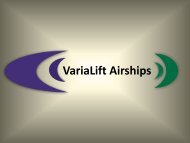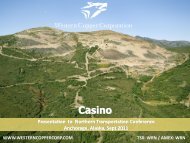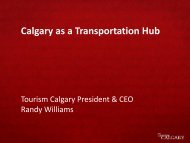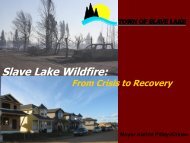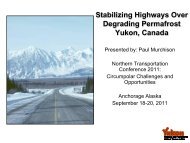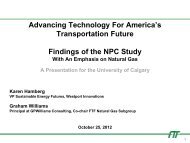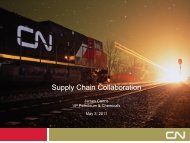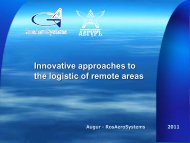Dr. Bruce Hellinga, Professor, Waterloo University - Van Horne ...
Dr. Bruce Hellinga, Professor, Waterloo University - Van Horne ...
Dr. Bruce Hellinga, Professor, Waterloo University - Van Horne ...
- No tags were found...
You also want an ePaper? Increase the reach of your titles
YUMPU automatically turns print PDFs into web optimized ePapers that Google loves.
Schedule adherence• Function of:– Intersection delays– Dwell times– Weather– Incidents– <strong>Dr</strong>iver characteristics– Traffic conditions
DistanceImpact of Signalized IntersectionsBus Scheduled/On-Call StopUnscheduled StopBCase 2CCase 1ATravel TimeTravel TimeTime
Transit Priority MeasuresImpact:• Mean delay• Variance of delay
Where to implement?• However, where should these treatmentsbe applied?– Require reliable data to quantify delays.• Current methods:1. field observation;2. simulation;3. analytical methods.
Use of AVL/APC dataStoppeddelay(d)Signal delayDelay from other causesDistance(X)Signalizedintersection 1Direction of travelSignalizedintersection 2
Theoretical foundation• Deterministic under-saturated queuingDistanceDistanceVehicletrajectoryTailqueueof(v/c) 1 < (v/c) 2Front ofqueue(v/c) 2rStoppeddelayTime(v/c) 1r 1rr 2StoppedStopped delaydelayDischargeFlow Ratesaturation1λTime
Proposed MethodologyFind the best fit “Boundary Line” to datad maxStopped delay (d)Can Compute:• # obs• Mean• Stdev• PercentilesX P1X P2Distance (X)
Proposed Methodologyd maxStopped delay (d)X P1X P2Distance (X)
GIS Data• Transit routes• Signalizedintersections
SegmentingSegment 1Segment 2Segment 3Segment 4Segment 6Segment 5
Delay1201008060402000 100 200 300 400 500Distance
Stopped Delay (s)8070605040302010016:30 16:40 16:50 17:00 17:10 17:20 17:30 17:40 17:50 18:00Time of Day807264564840322416800% 10% 20% 30% 40% 50% 60%Relative Frequency (%)
Cumulative Relative Frequency (%)100%90%80%70%60%50%40%30%20%10%0%0 20 40 60 80 100Stopped Delay (Seconds)
RouteDirection IntersectionMean delay(seconds)Std(s)COV90 % delay(seconds)QueueLength(metres)Proportion oftrips withidentifiedsignal delaySamplesizeTotalnumber ofservicetrips10 up HOMER WATSON @ Manitou Doon Village 34 25 0.7 69 91 81% 201 217 46710 down FAIRWAY @ Wilson 32 28 0.9 65 120 71% 258 214 16513 WB FISCHERHALLMAN @ Columbia 26 19 0.7 51 273 76% 250 230 721201 up ERB @ FischerHallman 22 22 1 55 75 65% 231 314 534201 dn FISCHERHALLMAN @ Queens 18 20 1.1 48 120 55% 213 319 18453 OB DUNDAS @ Main 18 21 1.2 52 90 55% 131 225 3741 ob QUEEN @ Charles 15 18 1.2 40 91 44% 180 330 106200 dn HESPELER @ Dunbar 14 21 1.5 49 91 46% 363 658 68411 IB KING @ Stirling 14 22 1.6 51 88 29% 84 252 12311 OB OTTAWA @ Alpine 11 15 1.4 36 60 54% 182 248 196Segmentlength(metres)18
Prioritized on the basis of IndexHOMER WATSON @ Manitou Doon Village: Route 10FAIRWAY @ Wilson: Route 10FISCHERHALLMAN @ Columbia: Route 13ERB @ FischerHallman: Route 201FISCHERHALLMAN @ Queens: Route 201DUNDAS @ Main: Route 53QUEEN @ Charles: Route 1HESPELER @ Dunbar: Route 200KING @ Stirling: Route 11OTTAWA @ Alpine: Route 11CHARLES @ Ontario: Route 15King @ Sportsworld Crossing Deer Ridge Cent: Route 52FISCHER HALLMAN @ LAURELWOOD: Route 13OTTAWA @ Charles: Route 200STRASBURG @ FOREST GLEN PLAZA: Route 12BLOCKLINE @ Strasburg: Route 201KING @ Benton Fredrick: Route 23UNIVERSITY @ WLU Ped: Route 9FISCHERHALLMAN @ Columbia: Route 201KING @ Gaukel: Route 1KING/WEBER @ Hwy 8 Ramp Kit: Route 200UNIVERSITY @ WLU: Route 29DUNDAS @ Main: Route 53UNIVERSITY @ Seagram: Route 29CHARLES @ Gaukel: Route 15UNIVERSITY @ TRANS CANADA TRAIL: Route 12LACKNER @ OLDFIELD ZELLER: Route 23WATER @ SAMUELSON: Route 2000% 20% 40% 60% 80% 100%Priority Index Value (%)19
What type of priority treatment?• Examine characteristics of intersection– E.g. turning movement being made by transit vehicle– Geometry– Estimates queue length– Signal timings– Location of upstream and downstream bus stops• Options:– Queue jump lane– Special transit phase– TSP20
Estimating impact of TSP21
Connected Vehicles• US DOT CV program– Integrated Dynamic Transit Operations (IDTO)• Enable travellers to “reserve” a connection• In real-time system can evaluate number ofreservation from passengers on the inbound transitunit and decide if outbound TU should wait.• Wide range of possible approaches butmuch work to still do!
Thank you!Q&A



